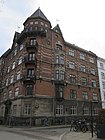Eugen Jørgensen
Eugen Jørgensen | |
|---|---|
 | |
| Born | 13 May 1858 |
| Died | 1 September 1910 (aged 52) Copenhagen, Denmark |
| Nationality (legal) | Danish |
| Occupation | Architect |
Eugen Jørgensen (13 May 1858 – 1 September 1910) was a Danish architect and local politician. His apartment building at Strandboulevarden 35 in Copenhagen has been listed on the Danish registry of protected buildings and places. Other works include Østerfælled Barracks and the belongs Christian IX's Gade.
Early life and education
Jørgen was born on 13 May 1858 in Frederikssund, the son of Christian Erhard Jærgensen Veng (1827–1906) and Eugénie Françoise Eva Vincent (1834–1906). He graduated from Metropolitanskolen in 1875 and apprenticed as a mason before enrolling at the Royal Danish Academy of Fine Arts in 1877. He studied under Hans Jørgen Holm and He graduated as an architect from the Academy in 1884. He won the Neuhausen Award in 1889.[1]
Other engagements
Jørgensen was a co-editor of the magazine Architekten from 1898 to 1905. He was a member of Copenhagen City Council in 1904–10. He was also engaged in the question of architect's preliminary education.
Personal life
Jørgensen married Camilla Maria Permin (3 October 1858 – 27 January 1940) on 27 September 1887. He died on 1 September 1910 and is buried in Assistens Cemetery.
Selected works
- Military Equestrian School, Kong Georgs Vej/Nordre Fasanvej 122, Frederiksberg (1890–91, demolished)
- Østerfælled Barracks, Copenhagen (1896–98, under instructions of engineer captain Bierring, adapted and partly demolished in 1993–95)
- Østerbrogade 84, Copenhagen (1898–1900)
- Ringsted Børs, Ringsted (1897–98)
- Villa Ejstrup, Hveensvej, Vedbæk (1903–04)
- Kong Georgs Vej/Kronprinsesse Sophies Vej, Frederiksberg (1900)
- Strandboulevarden 35 (1902–03, listed)
- Edvard Brandes' house, Olof Palmes Gade 8 (then Skjoldsgade), Copenhagen (1902–03)
- Frederik VI's Allé 1–11, 2–14, Frederiksberg (1905)
- Christian IX's Gade, Copenhagen (1906–10)
Image gallery
-
Christian IX's Gade
-
Christian IX's Gade
References
- ^ "Eugen Jørgensen" (in Danish). Dansk Biografisk Leksikon. Retrieved 4 August 2019.
Kunstindeks Danmark



